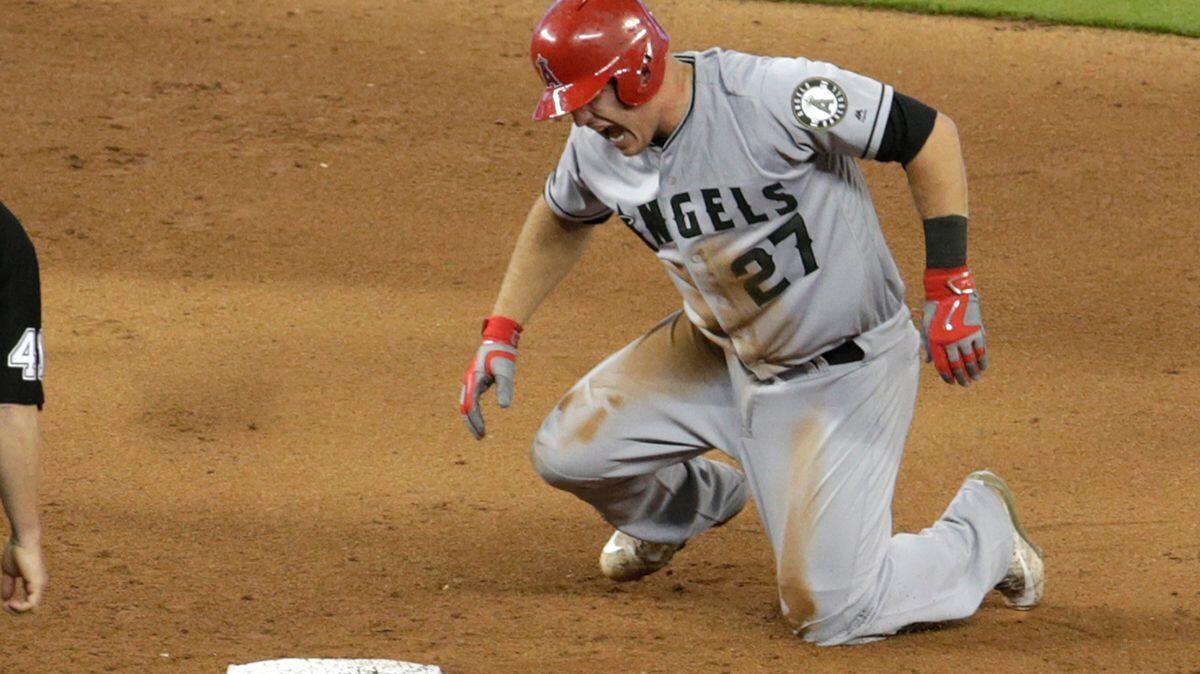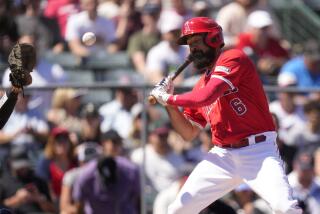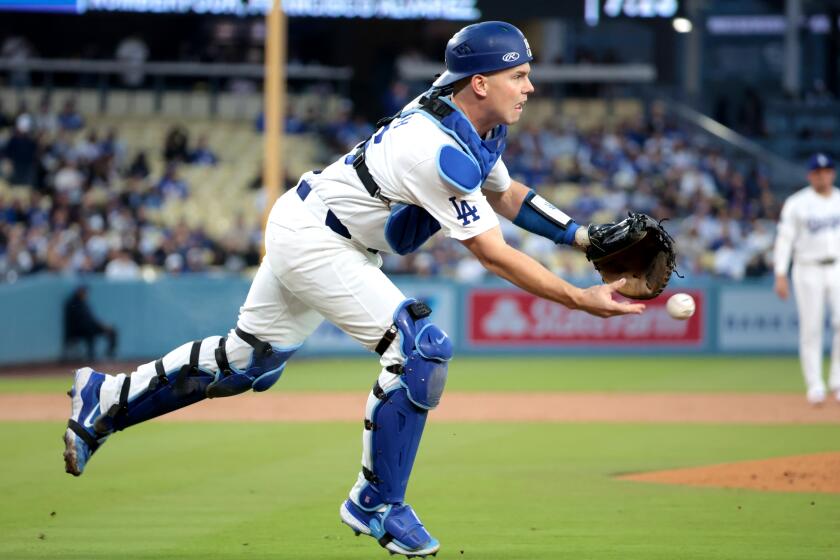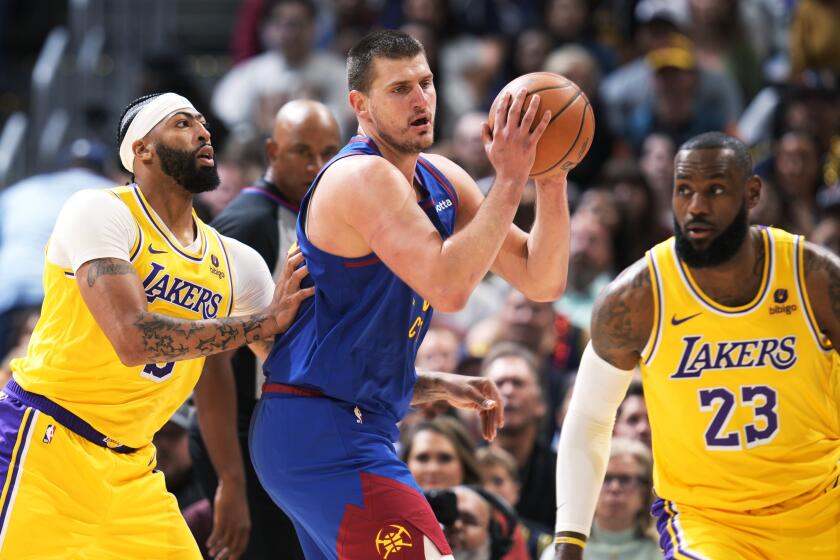Despite Mike Trout’s injury, Angels players appear all-in on head-first slides

Cameron Maybin wanted to please his new employer, so when the Angels suggested during spring training that he slide feet-first on stolen-base attempts in an effort to avoid injury, he complied.
“I tried it twice,” said Maybin, who suffered a torn ligament in his left thumb on a head-first slide into second last August while playing for the Detroit Tigers. “I got thrown out twice, and I was, like, over it. It’s too slow. It literally slows me down.”
The Angels, like most major league organizations, encourage players to slide feet first because it’s considered safer than sliding head first, a belief that was reinforced last week when star center fielder Mike Trout suffered a torn left-thumb ligament on a head-first slide into second.
A head-first slide exposes the fingers, hands and wrists to injury, and if a player slides beyond or away from the bag, he can jar an elbow or a shoulder while grabbing the base to stop his momentum.
A player can jam his wrist on the ground while bracing himself on a feet-first slide, and if he goes too hard and too late into the bag, he can sprain an ankle. But if executed properly, a good feet-first, pop-up slide is less dangerous.
Unless you’re like Maybin, Trout and the many big leaguers who grew up sliding head first into bases and feel uncomfortable doing anything different.
“It’s just a freak thing,” said Trout, who underwent surgery last Wednesday and will be out for six to eight weeks. “I’ll play the same way — I’m still gonna slide head-first, obviously with a guard now.
“I tried to slide feet first in spring. I just don’t feel comfortable doing it. I think I have more control when I dive head-first. They say [feet-first sliding] doesn’t slow you down, but it feels like I’m slowing myself down a little bit.”
Maybin, who stole 40 bases for the San Diego Padres in 2011, felt a similar sensation when he tried feet-first sliding this spring.
“It was physically awkward,” said Maybin, who was traded to the Angels last November. “I’m tall and I run kind of low to the ground, like Rickey Henderson did. When I tried to contort my body back upright [to start a feet-first slide], it just physically slows you down.
“I’m successful, and comfortable, doing it the way I do it, so I’m gonna keep doing it that way. I know I messed up my thumb last year, but it’s part of the risk that comes with the game.”

Players typically slide feet-first into second when attempting to break up double plays, and they rarely slide head-first into home, where a collision with a catcher in full gear could risk a serious neck injury in addition to hand, arm and shoulder injuries.
The Angels stress the perils of the head-first slide throughout the minor leagues, but as general manager Billy Eppler said in the wake of Trout’s injury, “It’s really hard when something is instinctual.” Forcing a player to change could make him more susceptible to injury.
“Some guys have tried to go feet first, and it’s actually more dangerous because they’re not used to doing it,” Angels third-base coach Ron Roenicke said. “When you think about it, sliding head first is the easiest thing to do, because you’re kind of low and you just drop down, and guys are used to diving instinctively.
“If you’re going feet first, you’ve got to figure out, ‘How do I get my leg in the air; where do I tuck my leg under?’”
The 2014 expansion of instant replay to include, among other things, tag plays has further muddled the head-first vs. feet-first sliding debate.
In a nationally televised May 27 game at Dodger Stadium, Ian Happ of the Chicago Cubs was ruled out — after a replay review — when the momentum of his feet-first slide on an apparent double caused him to pop up off the bag while Dodgers shortstop Corey Seager kept the tag on him.
Fox analyst John Smoltz, a Hall of Fame pitcher, said overturned calls such as that one are causing more players to slide head first into second because it is easier to maintain contact with the bag.
“I haven’t noticed more guys sliding head first, but what he’s saying is correct,” Roenicke said of Smoltz. “When you go feet first, you’re usually sliding later. So the later you slide, the faster you’re going, and when you impact that bag, there’s a pop, and a lot of times you come up off the base.”
Teams train infielders to keep tags on baserunners until a play is complete in case the runner comes off the bag.
“It’s unfortunate because that’s not the intent of replay,” Roenicke said. “It was not put in for the guy who is safe and who is off the bag.”
Joe Torre, executive vice president for baseball operations, said replay officials consider the intent of a runner and his actions on a slide before determining whether to overturn a call because he may have lost contact with the bag for a split second.
“Your rear end hits the ground and you make an attempt to stay on the base — if you come off the base a little bit, chances are you’re not going to get flagged,” Torre said. “But you have to make an attempt.
“A lot of guys slide late and, all of a sudden, after everything’s done, you see them reaching their hand out. That’s not the same thing. If the intent is there to stay on the base, it’s still judgment, but for the most part, I think they’re going to be OK.”
A head-first slide doesn’t guarantee a runner will maintain contact with the bag. The Angels’ 3-2 loss to Minnesota on Sunday ended when Ben Revere’s head-first slide on an attempt to steal second base took him past the bag. Revere was initially ruled safe. Upon replay review, he was out.
“We don’t encourage sliding head first, but now, because of replay, it’s hard to hit that bag and keep your foot on the base,” Angels bench coach Dino Ebel said. “I don’t think, in the moment, guys slide and think, ‘I’ve got to go head-first because I need to stay on the bag.’
“I think the guys who naturally go head-first, they’re going to go head-first. And you don’t want to change what they do instinctually, because that’s when they get hurt.”
Times staff writers Pedro Moura and Bill Shaikin contributed to this report.
Follow Mike DiGiovanna on Twitter @MikeDiGiovanna
More to Read
Get our high school sports newsletter
Prep Rally is devoted to the SoCal high school sports experience, bringing you scores, stories and a behind-the-scenes look at what makes prep sports so popular.
You may occasionally receive promotional content from the Los Angeles Times.







